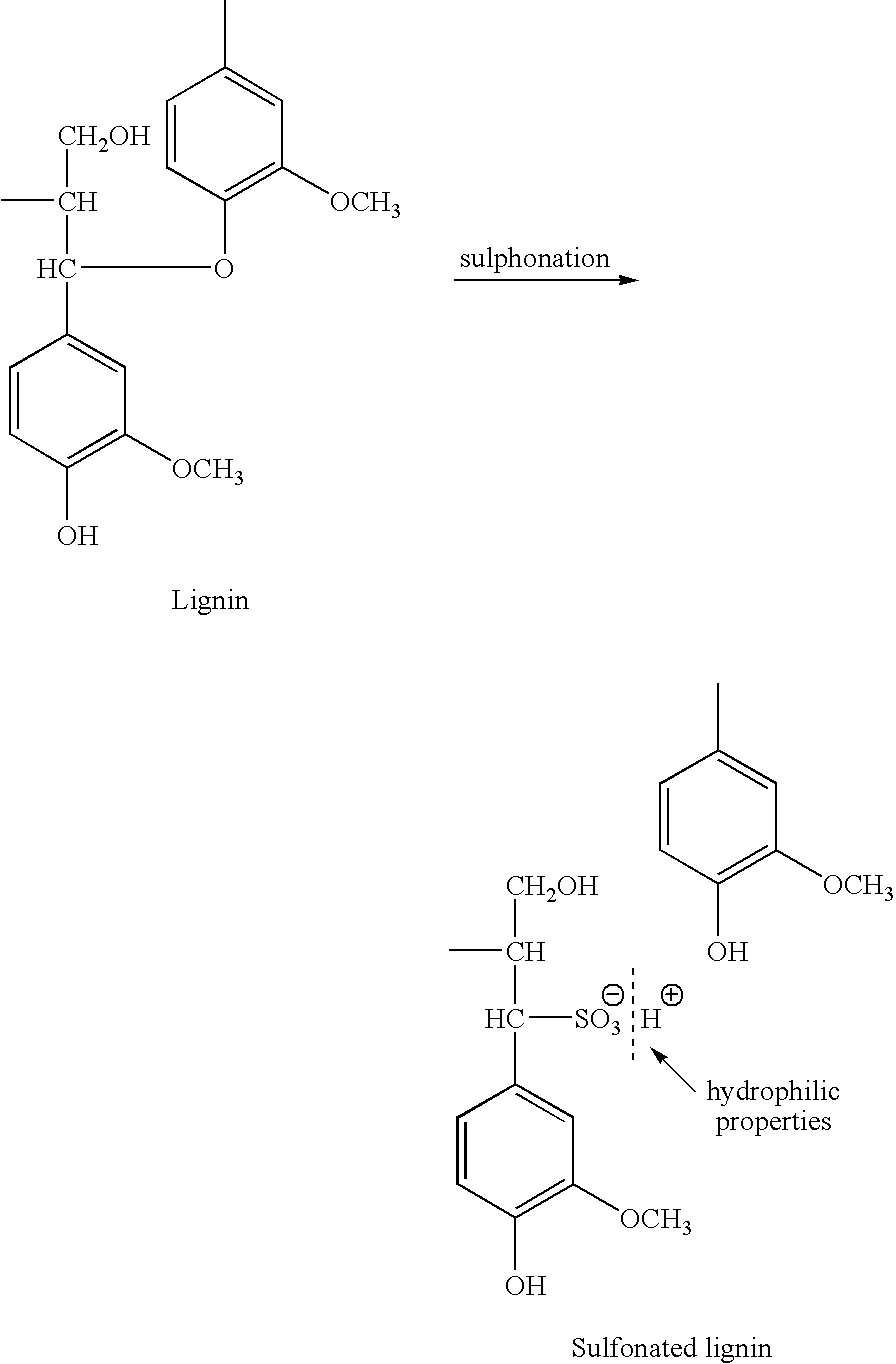Sulfonation of pulp produced by alkali pulping process
a technology of alkali pulping and sulfonation, which is applied in the field of lignocellulosic pulp delignification, can solve the problems of more difficult bleaching of alkali pulping, stronger and darker color of alkali pulp produced, and no reference in the cited references is disclosed
- Summary
- Abstract
- Description
- Claims
- Application Information
AI Technical Summary
Benefits of technology
Problems solved by technology
Method used
Image
Examples
example 1
[0073]An unbleached hardwood pulp sample, collected from a commercial southern US mill was analyzed and found to have a kappa of 15.5. This unbleached pulp sample was first digested with a water solution containing sulfur dioxide (SO2), at 11% consistency, for a period of 2 hours at 90° C. After washing with fresh water and washed water removed, the SO2 pretreated pulp was bleached with bleaching chemicals such as chlorine dioxide (ClO2), caustic (NaOH) and hydrogen peroxide (H2O2) and in a three stage DEpD bleaching sequence. The pulp bleaching in the first D stage was carried out at 5% pulp consistency, for 50 minutes at 65° C. After pulp washing, washed D pulp was bleached in Ep stage at 11% consistency, for 50 minutes at 85° C. Washed Ep pulp was bleached in the final D stage at 11% consistency, for 3 hours at 70° C. The final bleached pulp was measured for brightness. Using a ClO2 dosage of 14 lbs / bdt in the first D stage, 10 # / bdt of hydrogen peroxide (H2O2) and 24 # / bdt of Na...
example 2
[0076]An unbleached softwood pulp of pine wood species collected from a southern US mill was analyzed and found to have a kappa of 28.5. This unbleached pulp sample was first digested with a water solution containing sulfur dioxide (SO2), at 11% consistency, for a period of 2 hours at 90° C. After washing with fresh water and wash water removed, the SO2 pretreated pulp was bleached with bleaching chemicals such as chlorine dioxide (ClO2), caustic (NaOH) and hydrogen peroxide (H2O2) and in a three stage DEpD bleaching sequence. The pulp bleaching in the first D stage was carried out at 5% pulp consistency, for 50 minutes at 65° C. After pulp washing, washed D pulp was bleached in Ep stage at 11% consistency, for 60 minutes at 80° C. Washed Ep pulp was bleached in the final D stage at 11% consistency, for 2 hours at 75° C. After washing the final D stage pulp was analyzed for brightness. Using a ClO2 dosage of 40 lbs / bdt in the first D stage, 10 # / bdt of hydrogen peroxide (H2O2) and 5...
example 3
[0077]An unbleached softwood pulp of pine wood species collected from a southern US mill was analyzed and found to have a kappa of 28.5. This unbleached pulp sample was first digested with a water solution containing sulfur dioxide (SO2), at 11% consistency, for a period of 2 hours at 90° C. After washing with fresh water and wash water removed, the SO2 pretreated pulp was bleached with bleaching chemicals such as chlorine dioxide (ClO2), caustic (NaOH) and hydrogen peroxide (H2O2) and in a five stage stage DEpDED bleaching sequence. The pulp bleaching in the first D stage was carried out at 5% pulp consistency, for 50 minutes at 65° C. After pulp washing, washed D pulp was bleached in Ep stage at 11% consistency, for 60 minutes at 80° C. Washed Ep pulp was bleached in second D stage at 11% consistency, for 2 hours at 75° C. Washed second D stage pulp was bleached in E stage at 11% consistency, for 45 minutes at 80° C. Washed E pulp was bleached in final D stage at 11% consistency, ...
PUM
| Property | Measurement | Unit |
|---|---|---|
| retention time | aaaaa | aaaaa |
| temperature | aaaaa | aaaaa |
| temperatures | aaaaa | aaaaa |
Abstract
Description
Claims
Application Information
 Login to View More
Login to View More - R&D
- Intellectual Property
- Life Sciences
- Materials
- Tech Scout
- Unparalleled Data Quality
- Higher Quality Content
- 60% Fewer Hallucinations
Browse by: Latest US Patents, China's latest patents, Technical Efficacy Thesaurus, Application Domain, Technology Topic, Popular Technical Reports.
© 2025 PatSnap. All rights reserved.Legal|Privacy policy|Modern Slavery Act Transparency Statement|Sitemap|About US| Contact US: help@patsnap.com

